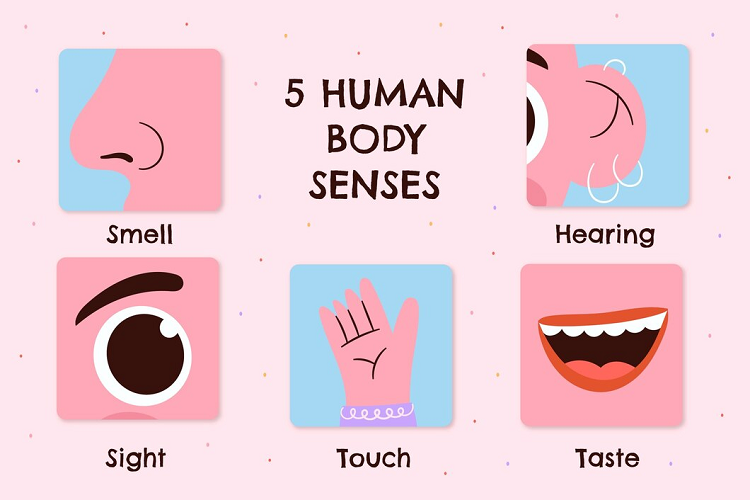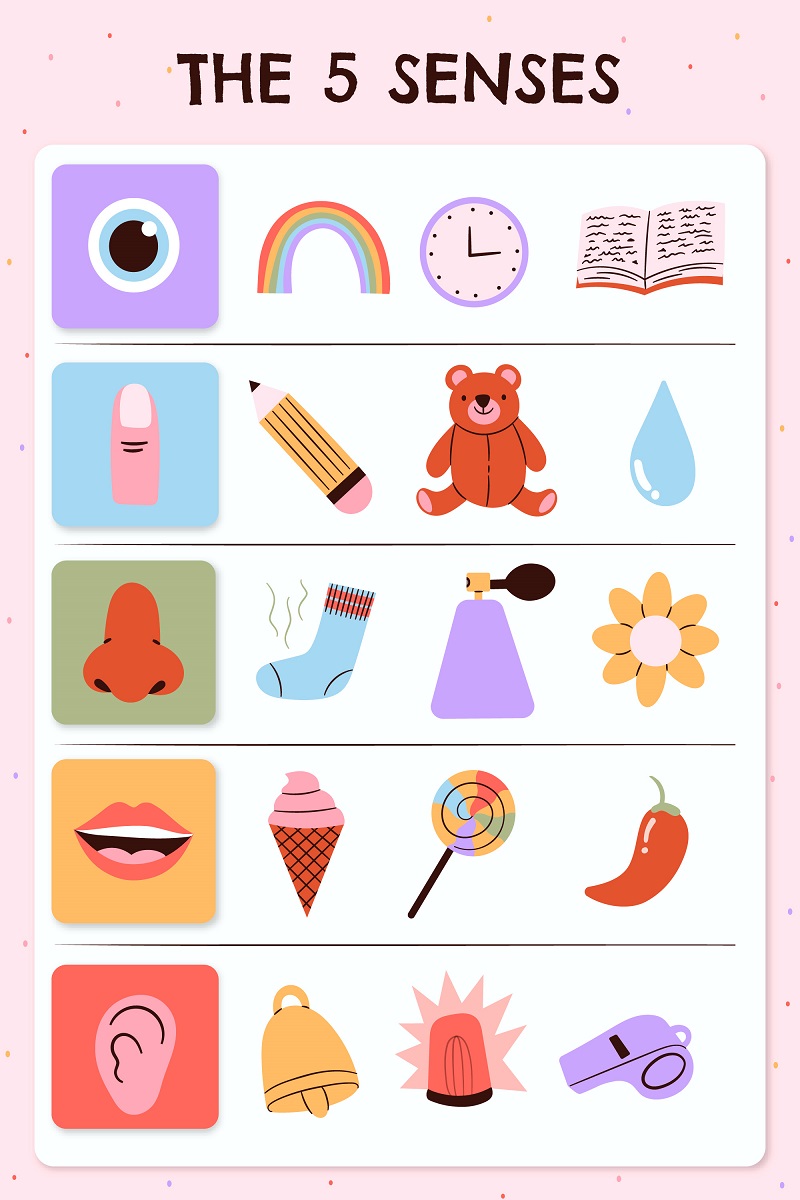The five human senses are often taken for granted — you can see, smell, taste, touch, and hear. Little do you realize how impactful having full command of your senses can be. After all, the best chefs have highly refined palates and senses of smell, and musicians have an excellent “ear.” Painters, photographers, and graphic designers all have an “eye” for visuals. And the development of those senses starts in childhood. So, how can you help?
What are the five senses?

These senses allow us to perceive and understand the world around us. Each sense has its own unique function and helps us gather information about our environment.
- Sight: Allows us to see light and color.
- Sound: Enables us to hear different frequencies of sound.
- Taste: Helps us perceive sweet, salty, sour, bitter, and umami flavors.
- Smell: Allows us to identify chemicals in the air and flavors of food.
- Touch: Our skin helps us sense pressure, vibrations, and other types of touch.
By teaching children about the five senses, we help them develop a deeper understanding of how they perceive and interact with the world. It also enhances their observational skills, critical thinking, and language development.
7 Activities to Teach Kids About the Five Senses

Teaching the five senses is important because they are the primary ways we experience the world around us. Each sense provides unique information that helps us understand and interact with our environment. Here are 10 activities to teach kids about the five senses:
1. Encourage Active Engagement
In the classroom, you have myriad opportunities to get kids to use all of their senses, and you likely utilize them. But are you creating space for kids to actively engage? Active engagement requires feedback from the kids about what’s happening with their senses.
Often, without someone to guide them, they will take the role of passive observer. They may hear, touch, taste, feel, or see, but they’re brain doesn’t register the experience as meaningful.
To get kids actively participating, ask them questions about their experiences. After they’ve come in from climbing and swinging on playground equipment, ask about it. Get kids to tell you about the feeling of air on their skin and the sights and sounds of other kids.
Play music in the classroom and then ask kids to tell you what they heard — and let them try to recreate it! For every activity, urge your students to provide feedback that comes from their senses.
2. Let Kids Play with Their Food!
Food is a big deal, and it can engage all of the senses! Kids exposed to a variety of foods are more likely to eat a wider variety of foods later in life. While as a teacher you may not have direct control over your students’ diets, you can talk to parents.
Introduce the topic of engaging the senses, and how food can play a big role here. You can create a project for kids and families that involves them bringing in a new food to show and tell.
Give parents a list of ideas — it doesn’t have to be expensive. They could bring a roasted beet to class or a dragon fruit. At the same time every day, perhaps right before lunch, kids could try their new food and tell the class about the experience.
If you make this a yearlong project, every kid could end up trying the different foods other kids brought in. You could create a discussion around different tastes and preferences.
3. Explore and Collect on Nature Trails
Another activity that engages all five senses is walking on a nature trail. When you’re locked in a classroom with only a few minutes of recess, it’s easy to shut down the senses. But get out on the trail, and sights, sounds, smells, and feelings come alive.
If you forage for wild food, you can even get your taste buds involved! And even if you don’t have a nature trail, space, or garden at your school, you still have options.
Plan field trips to local nature trails or botanical gardens and have discussions with kids beforehand. Ask them to write in a nature journal about what they observe and bring a basket to collect items from the wild.
Beyond those trips, consider organizing a garden at school and creating natural space. And of course, encourage parents to take walks in nature on weekends or after school and discuss their kids’ observations with them.
4. Read Picture Books and Discuss
Enough cannot be said about reading aloud to kids. Picture books are a wonderful way to engage kids’ senses and teach them to pay attention to them. While many teachers and parents stop reading aloud to kids once they can read for themselves, this is a mistake.
Reading aloud encourages discussions both during and after. Indeed, reading is one of the few activities that helps kids imagine experiences they aren’t currently having.
Get kids to “oooh” and “ahhh” with you over pictures of yummy food. Mimic splishing and splashing through a creek pictured on the page. Have kids make animal sounds when they come up in the book. Then, have them discuss what senses were engaged during the reading. These shared experiences are ones they will remember for life, and they will certainly sharpen their senses.
5. Teach Kids to Meditate
It might seem counterintuitive, but meditation is an especially marvelous way to teach kids about their senses. Meditation has been studied for decades and practiced for millennia. It is one of the most profound practices for bringing the imagination to life.
Transcendental meditators have shown meditation can bring peace to violent neighborhoods. And doctors have seen meditation aid in physical healing. Of course it can help kids engage their senses.
Have your students sit quietly for just five minutes each day. You can do this every day to strengthen each of the senses. Start by having them visualize a specific image. Then, play a slow song and have them sit with their eyes closed and listen.
Give kids something to touch another time and meditate on the feeling. You can then have them taste something and then meditate on that. Finally, burn incense or spray a scent in class and have kids sit with the smell.
6. Sing Songs about the Five Senses!
Singing songs that focus on the five senses can help reinforce vocabulary and make learning more enjoyable. Consider adding a five senses song to your morning meeting or circle time.
Some sample lyrics for a song about the five senses.
(Verse 1)
(Verse 1) I see with my eyes, the colors so bright, The world around me, a beautiful sight. I hear with my ears, the sounds all around, Birds singing sweetly, a joyful sound.
(Verse 2) I taste with my tongue, flavors so sweet, Ice cream, chocolate, a delicious treat. I smell with my nose, scents in the air, Flowers blooming, a fragrance so rare.
(Bridge) I touch with my hands, textures I explore, Soft and smooth, rough or more. With my senses, I learn and grow, Discovering the world, as I go.
Feel free to use these lyrics as inspiration to create your own five senses song or adapt them as needed. Happy singing and teaching!
7. Science Experiments
Conduct simple science experiments that involve the five senses. Here are two simple science experiments that involve the five senses:
Experiment 1: Sound and Materials
Materials needed: Different objects (metal spoon, plastic cup, wooden block, etc.), a bell or chime.
Procedure:
- Gather several different objects.
- Have the students strike each object gently with a bell or chime.
- Ask the students to listen carefully and describe the sound produced by each object.
- Discuss how different materials produce different sounds and why.
Extension:
Ask students to close their eyes and try to identify the object being struck based on the sound it produces. This will further enhance their auditory perception.
Experiment 2: Taste Bud Experiment
Materials needed: Cotton swabs, four different flavors (sugar, salt, lemon juice, and unsweetened cocoa powder).
Procedure:
- Dip a cotton swab into each flavor.
- Have the students gently touch their tongue with each flavored cotton swab, one at a time.
- Ask the students to describe the taste sensation they experience with each flavor.
- Discuss how taste buds on the tongue help us perceive different tastes.
Extension:
Ask students to close their eyes and try to identify the flavor being tasted based solely on the taste sensation. This will further develop their ability to distinguish between different tastes.
Remember to provide appropriate supervision and ensure the safety of the students during these experiments. Enjoy exploring the five senses through these engaging science activities!
Conclusion
In the end, there are many amazing activities you can engage kids in to teach them about their senses. Each of these experiences will help them strengthen their senses and become more observant. As they develop their strengths, they may find themselves drawn more to one or two than the others. This attraction may help them figure out how they want to engage with the world when they grow up. And all because you played some fun games in class.



